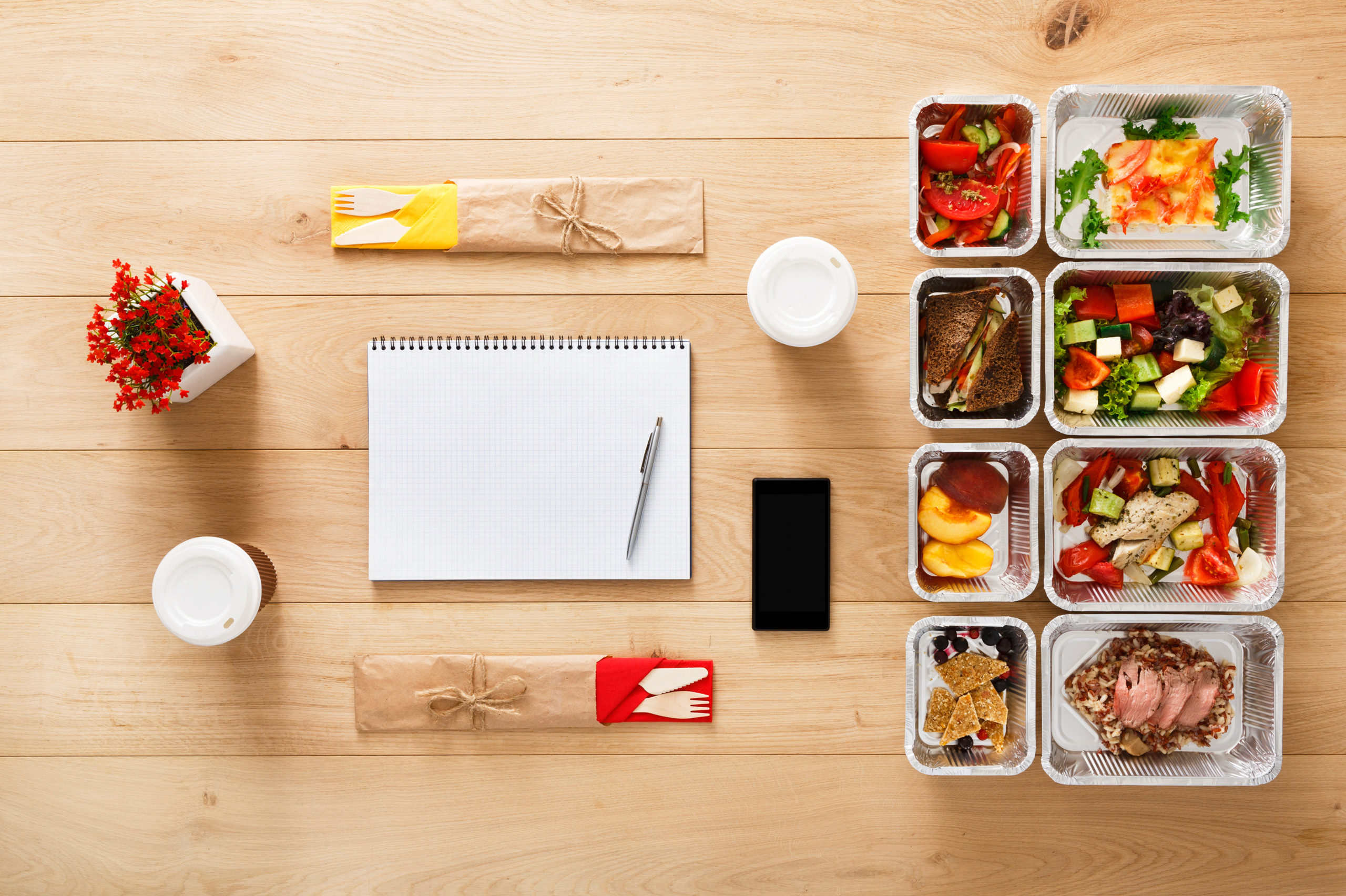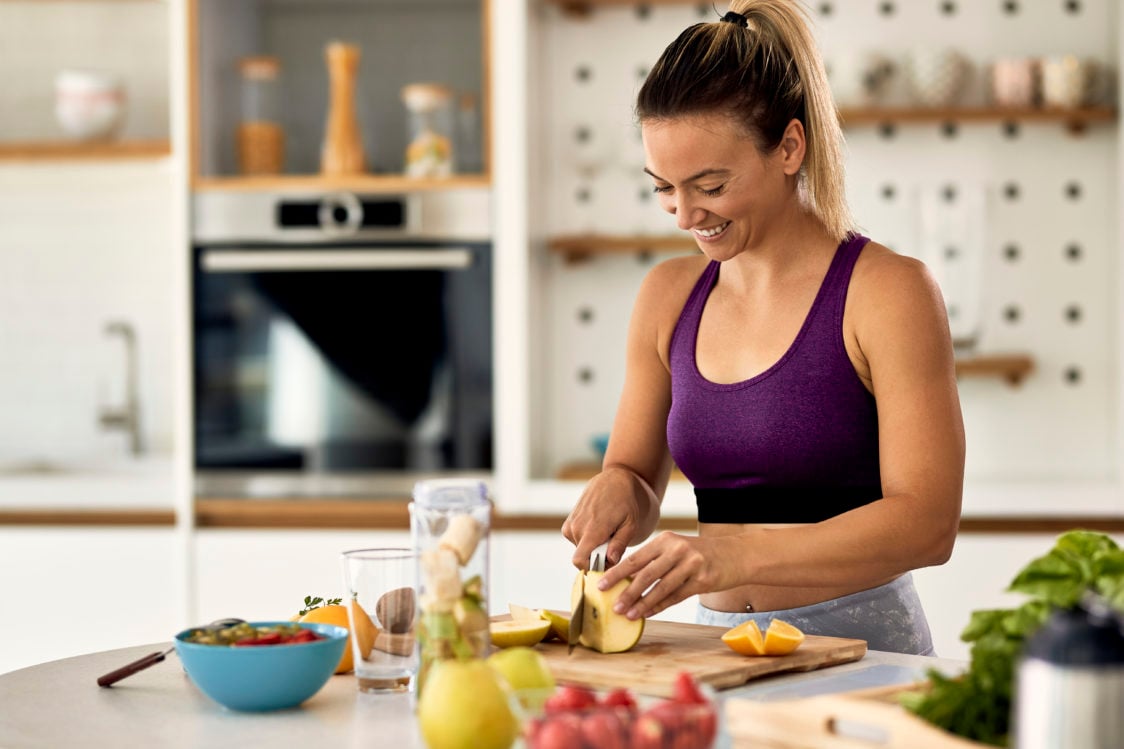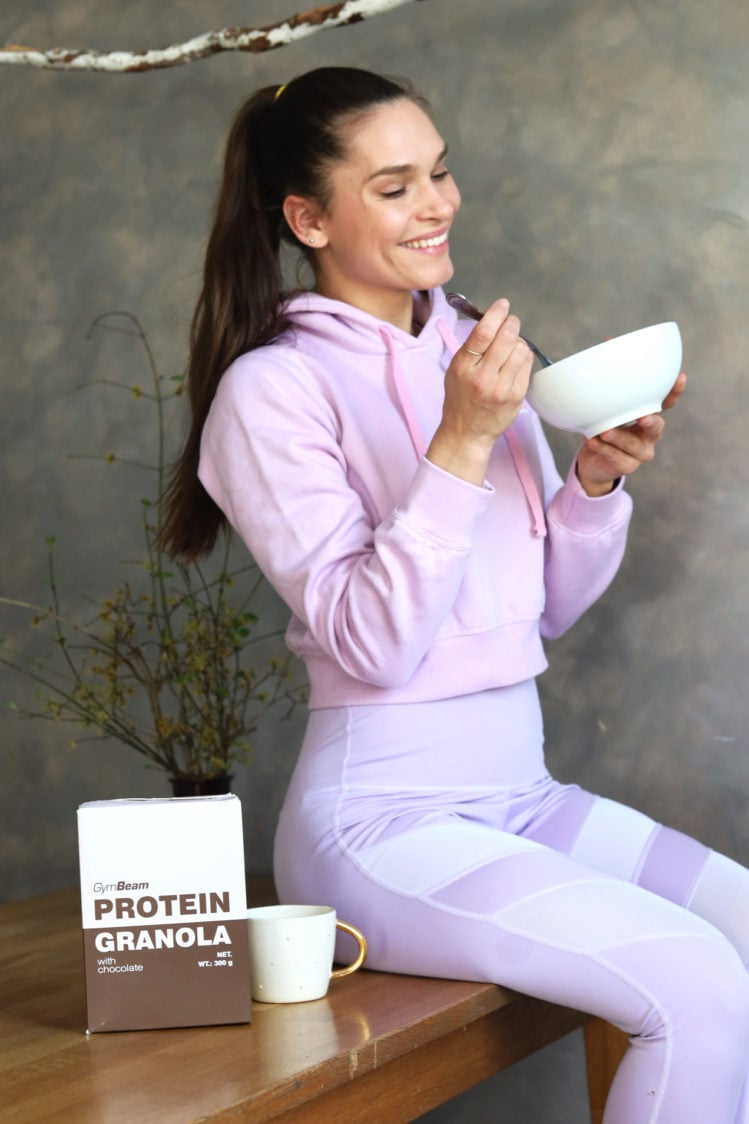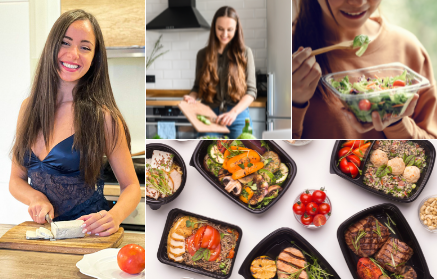Table of Contents
Planning and preparing meals ahead will make it much easier to meet goals, whether you’re trying to lose weight, gain weight healthily, or have enough energy for all your activities. It also saves you valuable time, money and thinking about what to cook quickly when you’re hungry. This will give you more control over what you eat, and support your determination to achieve your dream body.
In this article, we have prepared a weekly meal plan for you with five meals daily, with an average calorie value of 2000 kcal. It is set for the needs of a person with a sedentary job and who undertakes sporting activity several times a week. It can be used, for example, by women who exercise regularly and try to lose weight slowly. But it is also suitable for men who exercise less and who strive to lose weight. In addition, you can customize this menu according to your needs or use it as inspiration.
What are the benefits of a meal prep?
Preparing your meals ahead of time requires planning and good organisation, but it certainly pays off.
1. You can achieve your goals more easily
When you plan your meals according to a well-adjusted diet plan, you will increase your chances of success in weight loss, healthy weight gain or any other goal you have set. A balanced diet will also support sports performance, muscle growth and regeneration. A study has also produced interesting results, suggesting that a meal prep is associated with higher amounts of both fruit and vegetables eaten and a higher likelihood of maintaining a healthy weight. [1–2]

2. You will save time and money
You can prepare your main food and portion it in containers. You can set aside, for example, one to two hours on the weekend and then the same amount of time during the week. This way you will prepare several portions of sides, meat or other protein-rich foods that will last you for two to three days.
A pre-prepared meal is then just heated up, enriched with fresh vegetables and a balanced dish is out in the world. This will save time so you can use it for your hobbies. Meals prepared at home are also typically cheaper than meals in restaurants.
3. You won’t have to improvise
If you don’t have your food ready and you’re hungry, you’ll probably eat the first thing you see. Meals prepared in advance will ensure that you do not subject yourself to unhealthy sweets or fatty fast foods in the moments when you are hungry like a wolf. [3]
4. Prepare your food to your liking
You know your tastes best, and you know how to please them. When preparing food, you can use your favourite herbs and spices and experiment with their combinations in various ways. [3]
5. You will eat regularly
Meal prep will also ensure that you don’t miss lunch or snacks, which could lead to overeating later in the day, or frequent evening refrigerator raids. A regular diet, on the other hand, is associated with higher weight loss success. You will simply give your body everything it needs, and this will give you a balanced energy level throughout the day and not make you feel unduly tired. [4]
You might be interested in these products:
Weight loss plan for people with sedentary jobs
We will plan a menu for Valentine, who has been trying to lose weight through strict diets for several years. But these diets never produced long-term results. This time, therefore, she decided to take a more specific and sustainable path.
Valentine calculated her energy intake, which should give her a gradual weight loss. She’s thirty years old and works at a bank, and she commutes by tram. She has a sedentary job. But nowadays, she tries to walk as much as possible to support her efforts. She also visits the gym twice a week, where she mainly does strength training, and goes for a thirty-minute jog twice a week. She currently weighs 79 kg, measures 175 cm and has an estimated 27% body fat.

When she entered those values into the energy intake calculator, it determined she should consume approximately 2021 kcal, 245g carbohydrates, 134g protein and 56g fat. When planning the menu, we will thus try to get as close as possible to these recommendations.
Valentine eats five times a day and has no food allergies or other restrictions. She likes to alternate animal and plant protein sources, as well as different kinds of sides, fruits and vegetables. She usually manages to eat breakfast at home or takes a prepped meal in a container to work when she can’t eat it in peace in the morning. Likewise, she also prepares and portions snacks and lunch in containers. She takes it all in a bigger handbag or food bag, so she has food with her for the day, and at work she doesn’t have to think about what she’s going to eat anymore.
As a result, she won’t end up eating lunch at a nearby fast food restaurant, and she won’t eat a whole chocolate as a snack, as she did in the past. She now tries to eat a full meal every two to three hours, which, thanks to its balanced nutritional profile and sufficient protein and fibre, dependably satiates her.
This diet also suits men who have sedentary jobs, exercise occasionally and are trying to lose weight. Whether it is suitable for you can simply be determined by the calculation in our online calculator. Alternatively, you can adjust it slightly to fit your needs more accurately.
If you are interested in how to set your energy and nutrient intake according to your goals, read our article How To Calculate Your Energy and Macronutrient Intake For Weight Loss Or Muscle Gain?

Sample weekly diet for 2000 kcal
Within a week, Valentine doesn’t have to eat exactly 2021 kcal every day, 245g carbohydrates, 134g of protein and 56g of fat, as recommended by the calculator. We cannot exactly calculate it this way because we are never 100% sure that what we eat is really the same value that we calculated. It is more than enough if the long-term average matches these values.
The overall energy value is influenced by, for example, kitchen preparation, fibre content or the efficiency of digestive system. In addition, each person has a different genetic makeup and hormonal environment, which are factors that also influence energy metabolism. [5-6]
Thus, the values calculated by our online calculator do not necessarily reflect 100% of the actual quantity because of the factors mentioned above. But they give you an idea of how much you should eat on average per day. Based on this, you can easily observe your body’s reaction and continue to adjust your diet.
The amount in the meal plan corresponds to the raw ingredients (before cooking). The resulting nutritional values may vary according to the composition of the particular food.
Monday
- Total intake per day: 2030 kcal, 137g protein, 241g carbohydrates, 54g fat, 40g fibre [7,13]
Daily Menu | Food |
|---|---|
| Breakfast | Porridge – 5 grain oats (50g), protein (vegan/whey 30g), peanut butter (20g), banana (100 g), calorie-free chocolate syrup (10g) |
| Snacks | Fat-free Greek yogurt (140 g), mandarine (100 g), crunchy muesli (25 g) |
| Lunch | Chicken curry (150g), oil (5g), rice (70g), steamed vegetables (150 g) in oil (5g) |
| Snacks | Knäckebrot (40g), cottage cheese (100g), carrot (100g) |
| Dinner | Pasta (70g) with tuna in brine (90g) and tomato sauce (150g), rapeseed oil (10g) |
Tuesday
- Total intake per day: 2017 kcal, 132g protein, 246g carbohydrates, 53g fat, 34g fibre [7,13]
Daily Menu | Food |
|---|---|
| Breakfast | Scrambled eggs (1 egg + 25g liquid egg whites) with green beans (100 g), cooked in ghee (10g), rye bread (100g) |
| Snacks | Chocolate Milkshake (1), grapes (150g) |
| Lunch | Bulgur (70g) with tofu (natural 150g), steamed zucchini and tomatoes (150 g) roasted in olive oil (10g) |
| Snacks | Rice mash (50g) with protein (25g) and raspberries (50g) |
| Dinner | Sardine spread (sardines in brine (90g), butter (10g), mustard (5g), onion, salt and pepper to taste), rye bread (80g), bell pepper (100g) |
Wednesday
- Total intake per day: 2028 kcal, 141g protein, 239g carbohydrates, 53g fat, 32g fibre [7,13]
Daily Menu | Food |
|---|---|
| Breakfast | Overnight oats: oat flakes (50g), white yogurt 2,7% (50 g), protein (15g), strawberries (100g), chopped dark chocolate (10g) |
| Snacks | Skyr natural (150g), protein granola (50g) |
| Lunch | Quinoa bowl: quinoa (70g), baked tempeh (100g) with soya sauce and herbs (without oil), avocado (30g), cherry tomatoes, cucumber and rucola (total 150g) |
| Snacks | Rice crackers (40g), turkey ham (50g), banana (120g) |
| Dinner | Quesadilla: wholegrain tortilla (90g), stuffed with pulled chicken (breast, 100g), 30% cheese (50g) and tomato salsa (100g) |
Thursday
- Total intake per day: 2034 kcal, 133g protein, 237g carbohydrates, 53g fat, 38g fibre [7,13]
Daily Menu | Food |
|---|---|
| Breakfast | Baked porridge: oat flakes (50g), egg whites (25g), protein (25g), forest fruit (150g), chocolate spread (20g) |
| Snacks | Kefir (250 ml), mixed dried fruit and nuts (40g) |
| Lunch | Baked salmon (125g) with green beans (150g) and sweet potatoes (300g) (on baking paper, without oil) |
| Snacks | Protein cookie (75g), pineapple (100g) |
| Dinner | Sandwich (wholemeal toast bread 100g), cottage cheese (50g), tuna in brine (90g), salad cucumber + lettuce (150g) |
Friday
- Total intake per day: 2028 kcal, 135g protein, 242g carbohydrates, 53g fat, 40g fibre [7,13]
Daily Menu | Food |
|---|---|
| Breakfast | Protein pancakes (pancake mix (50g), low-fat milk (100g), oil (3g), banana (120g), almond butter (20g), agave syrup (10g) |
| Snacks | White yoghurt 2.7% (120g), crunchy muesli (35g), apple (150g) |
| Lunch | Turkey breast (150g), with broccoli (150g) roasted in oil (5g), buckwheat (70g) |
| Snacks | Knäckebrot (40g), cheese 30% (50g), bell pepper (100g) |
| Dinner | Wholegrain tortilla (90 g) with roasted seitan (100g), fresh vegetables (150g) and yogurt dressing (white yogurt 30g, olive oil 5g, herbs) |
Saturday
- Total intake per day: 2012 kcal, 131g protein, 244g carbohydrates, 54g fat, 40g fibre [7,13]
Daily Menu | Food |
|---|---|
| Breakfast | Egg omelette: 1 egg, liquid egg whites (25g), cherry tomatoes, mushrooms and fresh spinach (total 150g) on oil (5g), and wholegrain bread (100g) with omelette |
| Snacks | Mug cake (mug cake mix (50 g), low-fat milk (50g), orange (120g) |
| Lunch | Rice noodles (70g) with chicken (breast, 150g), soya sauce, corn and peas (50g in total) roasted in oil (5g) |
| Snacks | Corn crackers (40g) with light cream cheese (20g) and turkey ham (50g), carrot (100g) |
| Dinner | Lettuce with light mozzarella (120g), canned chickpeas (100g) and olive oil (5g), rye bread (80g) |
Sunday
- Total intake per day: 2017 kcal, 136g protein, 240g carbohydrates, 56g fat, 31g fibre [7,13]
Daily Menu | Food |
|---|---|
| Breakfast | Pancakes: spelt flour (60g), baking powder, protein (25g), 1 egg, coconut oil for frying (5g), maple syrup (10 g) and low calorie fruit jam (25g) for garnish |
| Snacks | Rice crackers (40g), hummus (20g), natural tofu (80g) |
| Lunch | Sautéed beef (100g) with zucchini, bell pepper and red onions (150g) on ghee (5g), potatoes (300g) |
| Snacks | Protein bar (60g), apple (150g) |
| Dinner | Tuna spread (tuna in brine 90g, mustard 5g, cottage cheese 50g, salt, onion for taste), rye bread (100g), tomatoes (100g) |
How do you adjust your diet according to your needs?
The meals in your diet plan can conveniently be swapped around during the day. Feel free to swap your mid-morning snacks for the afternoon snack, or lunch for dinner. It’s entirely up to you, nothing’s set in stone. In case you are using intermittent fasting, eat all the courses in the time window you have set for your dietary intake.
You can mix up the different days in the menu according to your needs and preferences. You can even repeat some of them several times within a week. But it’s not appropriate to eat the same foods every day because then your diet won’t be varied enough, and you’ll probably soon stop enjoying the same meals over and over. In order to save time, you can always prepare the same lunch and dinner for the next two to three days. Then you don’t have to cook two new meals for the next day.
You don’t have to eat according to a schedule. On Monday, feel free to have the meals you have planned for Friday. Some foods have similar nutritional values, making it possible to replace them. For example, if you have bulgur planned and it’s missing from your pantry, you can replace it with the same amount of rice or couscous.
In such substitutions, however, always think that the raw ingredients you have chosen must have similar characteristics to the original. Perhaps natural cashew nuts should not be substituted for those coated in chocolate or white yogurt with low fat is not suitable to be substituted with fruit flavoured cream. These variants may contain more or less calories, as well as other values for proteins, carbohydrates and fats. Because of this, your daily intake could then be quite substantially different from the recommended one.

What foods have similar nutritional values?
- Cereals and pasta: Rice, bulgur, couscous, quinoa, buckwheat, pasta, spaghetti, noodles.
- Flours: Spelt, rye, buckwheat, rice, oat, whole wheat.
- Porridge (without added sugar, fat and other ingredients): Oat, rice, millet, buckwheat, corn, quinoa.
- Baked goods: rye, spelt, whole wheat, buckwheat.
- Long life baked goods: Rice, corn or graham crackers, knäckebrot.
- Legumes: Lentils, peas, chickpeas, beans.
- Fresh fruit with a low calorie content: Raspberries, strawberries, blueberries, blackberries and other wild berries.
- Fresh fruit with a medium calorie content: Oranges, mandarines, grapefruit, pomelo, kiwi, apples, pears, peaches, apricots, nectarines, plums.
- Fresh fruit with slightly higher calorie values: Banana, grapes, figs.
- Fresh vegetables: Tomatoes, cucumber, zucchini, peppers, green beans, spinach and other leafy vegetables. Carrots, corn, red beets and green peas have slightly higher caloric values.
- Potatoes, sweet potatoes and Jerusalem artichoke.
- Oils and fats: Rapeseed, olive, sunflower, coconut, ghee, flaxseed, avocado, pumpkin.
- Nuts and seeds (unroasted, unflavoured): Almonds, peanuts, cashews, Brazilian, macadamia, pistachio, walnut, hazelnut, etc.
- Nut butters (100% nut content, sugar and other ingredient free): Peanuts, cashews, almonds, etc.
- Meat: White lean meat: chicken, turkey breast, rabbit. Red lean meat: pork leg or tenderloin, beef hind quarters, veal, deer, boar.

How to increase or decrease the caloric value of your diet?
This diet is set to +- 2000 kcal, but if this does not suit you, you can adjust it. Snacks that have an average content of 250 – 300 kcal are a simple way to do this.
For example, if you need to reduce the caloric value by 250 – 300 kcal, you simply skip the morning or afternoon snack (or leave both, but reduce their weight by half).
Otherwise, if you want to add 250 – 300 calories, you can have twice the amount of one of the snacks or add a second dinner, which will correspond to the raw ingredients and their quantities.
How to measure progress?
Losing 0.5 – 1 kg of body weight per week is considered the ideal weight loss rate. However, in the case of being overweight or obese, weight typically decreases faster in the first phase of weight loss. [8]
Besides weighing, it’s also a good idea to take photos of your progression and measure your waist, across the hips, buttocks and thighs. Taking this kind of approach gives you a much better idea of how you’re doing. [8]
Try to do all the weighing and measuring at the same time of day and under similar conditions (after visiting the toilet, ideally in your underwear, measuring in the same place, etc.) and then record the results on your computer or in a paper journal. [9]
You can also take more detailed measurements once in a while, for example on the InBody machine, which assesses the amount of fat, muscle and water in your body in addition to your body weight. This will give you a better overview of the changes that are happening in your body. In some cases, the weight does not decrease. This is due to the fact that at the same time, there was a reduction in fat and an increase in muscle mass. As a result, the total percentage of fat in the body fell, an important indicator for both appearance and health. [10]
If you’re wondering why weight can change from one day to the next and what’s affecting it, read our article Why The Scales Show You A Higher Number and It’s Not Fat.
What to do if you don’t get results?
In case you don’t see any results even after a few weeks of strict adherence to diet, training, regeneration and everything else, you will have to be the one to make a difference. But don’t make any radical things, such as splitting your calorie intake, doing a detox or starting a drastic diet. These approaches do not guarantee lasting results and may endanger your health in the long run. [11]
You’re probably not losing weight because you’re not currently in a caloric deficit. Your energy expenditure is equal to or less than your intake, and you still weigh the same or gain weight easily. You can change this by adding sporting activities or more movement during the day.
How to increase energy expenditure with day to day activities and promote weight loss?
- Try to walk more during the day (walk to work or training).
- Include more active breaks at work or university (walking, a quick stretch).
- Walk to the shops if going for a smaller shopping.
- During a longer telephone call go for a walk.
- Take the stairs instead of using the lift.
- Then at the weekend, instead of a day’s rest with Netflix, go on a trip.
With these simple tips, you will burn more energy overall per day, and thus you can easily get into a calorie deficit and lose weight. If you move a little more, you don’t have to eat smaller amounts of food to lose weight. In addition, you will also support your health. [12]
What else can you do to kick-start your metabolism and increase energy output? You can find this out for yourself in our article Can I Have A Slowed Or Damaged Metabolism? 5 Tips To Speed Up Your Metabolism.

What should you remember?
Planning the menu and preparing and portioning meals ahead is a great step in the quest for your dream body. Ultimately, this will save you a lot of time, money and thinking about what to cook. You can plan your meals a week ahead and take inspiration from our sample diet. It can be easily adjusted and adapted to your needs. Then all you have to do is watch the progression and change the plan as necessary. Sooner or later, you will achieve your goal.
Did you take inspiration from today’s article on planning your meal prep? If you have someone who will find this article helpful, send it and your loved one’s in achieving their goals.
[1] Ducrot, P., Méjean, C., Aroumougame, V., Ibanez, G., Allès, B., Kesse-Guyot, E., Hercberg, S., & Péneau, S. Meal planning is associated with food variety, diet quality and body weight status in a large sample of French adults. – https://doi.org/10.1186/s12966-017-0461-7
[2] Mills, S., Brown, H., Wrieden, W., White, M., & Adams, J. Frequency of eating home cooked meals and potential benefits for diet and health: Cross-sectional analysis of a population-based cohort study. – https://doi.org/10.1186/s12966-017-0567-y
[3] Eat Yourself Skinny. My Weekly Meal Prep Routine! – https://www.eatyourselfskinny.com/my-weekly-meal-prep-routine/
[4] Paoli, A., Tinsley, G., Bianco, A., & Moro, T. The Influence of Meal Frequency and Timing on Health in Humans: The Role of Fasting. – https://doi.org/10.3390/nu11040719
[5] Capuano, E., Oliviero, T., Fogliano, V., & Pellegrini, N. Role of the food matrix and digestion on calculation of the actual energy content of food. – https://doi.org/10.1093/nutrit/nux072
[6] Hervik, A. K., & Svihus, B. The Role of Fiber in Energy Balance. – https://doi.org/10.1155/2019/4983657
[7] KalorickéTabulky.cz – – https://www.kaloricketabulky.cz/
[8] Nhs.Uk. Start the NHS weight loss plan. – https://www.nhs.uk/live-well/healthy-weight/start-the-nhs-weight-loss-plan/
[9] Progress Blog. What to Track When You’re Losing Weight .– https://theprogressapp.com/blog/what-track-losing-weight/
[10] BMI vs. body fat: Which number is more important? – https://goshenhealth.com/blog-articles/february-2017/bmi-vs-body-fat-which-number-is-more-important
[11] Oklahoma State University. The Health Risks of Fad Diets. – https://extension.okstate.edu/fact-sheets/the-health-risk-of-fad-diets.html
[12] Comana, F. A NEAT Approach to Weight Loss and Exercise – https://blog.nasm.org/exercise-programming/neat-approach-weight-loss
[13] U.S. DEPARTMENT OF AGRICULTURE - FoodData Central - – https://fdc.nal.usda.gov/

